September 24, 2013, 16:51
On desktop PCs you have the nice tool netstat to see which ports are open on the PC. A customer wanted to know, why his devices do not release there internet connection. The only tool I know, that will show open network connections, is called netstat. Unfortunately I did not find such tool for Windows Mobile and so I wrote one myself:
netstat for windows mobile
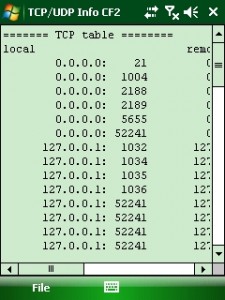
Continue reading ‘Mobile development: Netstat, know your device’s open ports’ »
September 24, 2013, 16:27
PocketPC and Windows Mobile does not support a hosts file as desktop windows. As I recently had to add an entry for a virtual machine running Mini SAP (Netweaver 7.01 Trial) I stumbled about how to add a host entry to a windows mobile device.
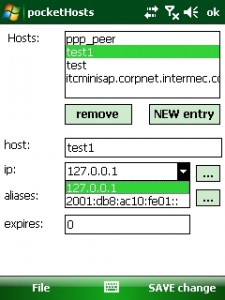
The platform builder help gives the details about how host entries are organized:
Host Name
The host name can be configured through the HKEY_LOCAL_MACHINE\Comm\Tcpip\Hosts subkey. When an application calls gethostbyname or getaddrinfo, the registry is queried first, before a DNS or WINS request is sent. If the host name is found in the registry, the registry values are returned.
The following table shows the values for the HKEY_LOCAL_MACHINE\Comm\Tcpip\Hosts\<Host Name> subkey.
| Value : type |
Description |
| Aliases : REG_MULTI_SZ |
This value stores the aliases by which this host is known. |
| ExpireTime : REG_BINARY |
If the current time, obtained by calling GetCurrentFT, exceeds the value in ExpireTime, the entire Host Name subkey is deleted the next time that gethostbyname is called. The length of this value is 8 bytes. |
| ipaddr : REG_BINARY |
This value stores the IPv4 addresses associated with this host name. The length of this value is 4 bytes per address. |
| ipaddr6 : REG_BINARY |
This value stores the IPv6 addresses associated with this host name. The length of this value is 20 bytes per address (16 bytes for address and 4 bytes for Scope ID). |
So, there is no simple hosts file.
Continue reading ‘Mobile development: pocketHosts-Edit Windows Mobile hosts entries’ »
May 13, 2013, 16:36
The event db (it is my naming) holds all events and actions that can be invoked to launch an app or fire some events.
NotificationList
The tool shows all known notifications on a WM device. You can browse the event db and examine the defined events. Additionally the tool shows power change notifications.
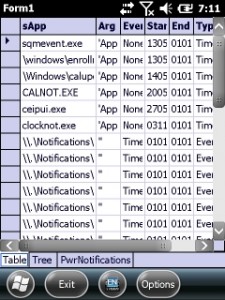
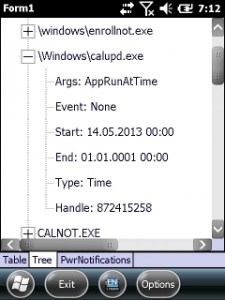
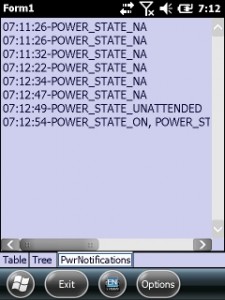
In the mid window above you can see there is a timed event that will occur at 0:00 and start \windows\calupd.exe. This will wake your device all night and update the calendar entries for re-occurring schedules etc.
The right window shows the power notifications on a suspend/resume cycle.
Using the options menu you can save a list of the defined notification events.
Continue reading ‘Mobile Development: manage the event db, what wakes up your device’ »
April 19, 2013, 21:30
Screen layout changes from Windows Mobile 6.1 to Windows Mobile Embedded Handheld 6.5
The Windows Mobile screen geometry changed from Windows Mobile 6.1 and before to the actual Windows Mobile 6.5 (also called Windows Embedded Handheld). Not only the geometry changed, the layout also changed. The Start icon is now moved to the bottom whereas before WM65 the start icon was on the left in the taskbar.
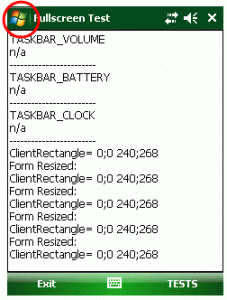
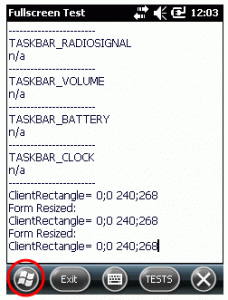
The taskbar and the menubar was about 26 pixels in height. With WM65 the taskbar is about 18 pixels in height and the menu bar occupies 34 pixels in height.
| QVGA screen geometry |
Windows Mobile 6.1
|
Windows Mobile 6.5
|
| taskbar |
26
|
18
|
| menubar |
26
|
34
|
| client size |
240;268
|
240;268
|
| client size height no taskbar |
240;294
|
240;302
|
| client size height no menubar |
240;294
|
240;286
|
You can see that assuming a fixed client size will give problems with the layout of the application, especially if menubar and taskbar height are assumed as being 26 pixels all the time.
Applications that only use the client size with the taskbar and menubar visible, will show normally, as the resulting client size does not differ between WM61 and WM65.
Tags:
autoscale mode,
Compact Framework,
form factor,
fullscreen,
QVGA,
screen,
VGA,
windows mobile,
Windows Mobile 6 Category:
CodeProject,
Programming,
Tips |
Comments Off on Windows Mobile 6.5: Changed Screen Geometry











 http://www.led-mg.de
http://www.led-mg.de